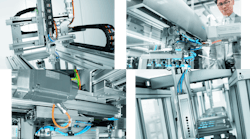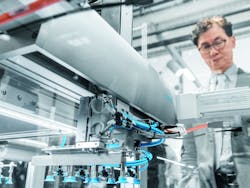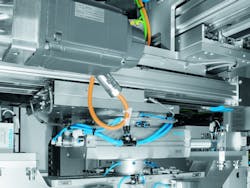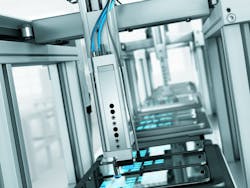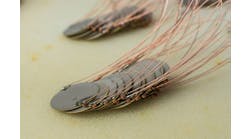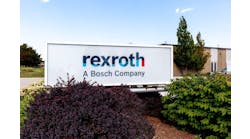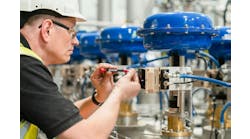A Control Design reader writes: Our production operation is part of a multinational portfolio that includes many manufacturing companies serving a variety of market segments. Yet our parent company’s procurement organization is determined to standardize as much equipment as possible. While we primarily use pneumatic actuators for pick-and-place applications, an increasing number of customers are requesting electric linear actuators. And one of our sister companies prefers hydraulics because of the heavy lifting and harsh environments where they operate. How do I emphasize the importance of keeping all three options to procurement? I fear we’ll lose key accounts if we’re unable to give customers what they want. And how do we decide between pneumatic and electric if the choice is left to us?
ANSWERS
Actuator advantages and disadvantages
Pneumatic, hydraulic and electric technologies bring their own unique features and benefits when being considered for an application. Questions that need to be asked pertain to what advantages are the most necessary in contrast to the disadvantages that can be tolerated.
Pneumatic systems are by far the least expensive of the three technologies and lightweight in comparison but are severely limited on their load capability and low accuracy due to the fact; compressed air can be very spongy and highly unrepeatable. Greater speeds can be achieved while being environmentally friendly; however, constant feedback can be complicated and cumbersome.
Hydraulic systems boast the largest load capability; they are very repeatable with extremely accurate feedback to boot. A hydraulic system’s ability to apply constant force and torque regardless of speed changes is definitely a game changer. The drawbacks really need to be considered since the overall system is extremely expensive, including an array of additional components such as power units, filters, pumps and motors. Also, they are less environmentally friendly with the possibility of oil leaks. They also operate at extremely slow speeds and require complex sizing.
Electric actuators give the highest precision positioning, while reprogramming is quick and easy. They allow for immediate feedback for diagnostics/maintenance while being very quiet in comparison to hydraulics and pneumatics. They are, however, far more expensive than other actuators. Due to their construction, which consists of motors, encoders and sensors, among other more delicate components, electric actuators are less well-suited for hazardous locations. When their internal components fail, the likelihood for repair is relatively low. Their bulky size installation can also be an issue. Pick your battles when choosing which technology to use in your application. Ask yourself what is necessary and what can I live with to get the most out of my actuators.
STEVE HORVATH / field application engineer / Allied Electronics & Automation
Multiple technologies across multiple applications
Different market segments have different needs and potentially standards or regulations. If addressing diverse market segments is the company strategy, then it is unlikely rigid standardization to one technology is possible. However, identifying a core group of actuators from within these technologies is still achievable.
To be successful, it is critical to listen to customers. By listening to what they want, you as the experts in your business can help them to see what best suits their needs. One technology rarely is the best solution for every application or project.
The point of separation for hydraulic actuators from pneumatic or electric is perhaps the easiest to define. The strength of hydraulics is high force and slower speeds. Typically, large, heavy equipment with exposure to outdoor elements is where hydraulic solutions are best-suited and most common. Neither pneumatic nor electric actuators are practical for these types of applications.
The application is the key to answering the question of whether to use pneumatic or electric. There are many situations where the best solution is a combination of both. The first consideration however is infrastructure. Does the facility currently have a compressed air system? Today many facilities do, as compressed air is used for many industrial applications over and above an automated handling system. If not, an electric solution may be a more suitable starting point.
For now, assume both compressed air and electricity are available options. Some key application questions can help to guide your direction.
- Does the function require long strokes/travel at high speed and short cycle time?
- Is free and flexible positioning needed (three or more positions)?
- Is smooth motion critical?
- Is the actuator task more than clamping or holding?
If you answer no to all these questions, then a pneumatic actuator is the most suitable starting point (Figures 1-4). If your answer is yes to any or all these questions you should explore electric.
Figure 1: This gantry robot has flexible-motion electric axis and high-force pneumatically powered gripper.
Figure 2: This pick-and-place gantry has flexible motion profile electric slides and pneumatically powered vacuum gripper.
Figure 3: This high-force, easy-setup pneumatic cylinder offers simple, two-position motion.
Figure 4: This electric light assembly features a combination of electrically powered slides featuring precise motion and pneumatically powered vacuum grippers for assured damage-free grip.
Table 1 explores the strengths and weaknesses of using pneumatic and electric actuators.
| Pneumatic | Electric | |
| Strengths |
• easy installation and setup |
• flexible motion profile |
| Weaknesses |
• energy losses with leakage |
• relative complex system design |
Costs are also important factors in the decision process. There are several different cost elements that sum to total cost of ownership and should be considered. They include:
- acquisition costs
- energy costs/efficiency
- installation costs
- implementation efforts costs (time, knowhow)
- maintenance costs.
In the study of many applications, acquisition costs typically favor pneumatics, but total cost of ownership depending on the application can favor electric actuator solutions over the life of the machine. In general, the rule of thumb as it relates to preference for economical/efficiency factors is as follows:
- Long strokes in combination with high cycle counts favor electrical solutions.
- Short strokes and/or long holding durations are perfect for pneumatics.
Many projects require both of these scenarios, so it becomes clearer that a combination of pneumatic and electric actuators is the best solution for many design projects.
DARREN O’DRISCOLL / product market manager / Festo
The case for standardizing to electric
This is a really great question and a relatively common one for machine builders who are encountering changing customer requirements with regard to technology. Ultimately, the decision should come down to a combination of your machine and customer design requirements. There are advantages to pneumatic (cost/availability), electrical (performance/precision) and hydraulic (capacity/reliability) actuators. When selecting an actuator that meets your design requirements, you must weigh the advantages and disadvantages of both. As a design engineer your analysis will typically focus on specific design requirements such as performance, accuracy, function, environment. I encourage you to consider factors that are relevant to other departments such as procurement. Factors such as cost, availability and maintenance requirements for your customers are all considerations that procurement attempts to take into account when making decisions about where to source components. By presenting your selection in terms that procurement can understand, you can strengthen your argument to select a specific actuator type. I think maintaining flexibility with regard to machine design is extremely beneficial from a design standpoint, and, by considering deciding factors outside your department, you can better make this case to procurement and upper management.
And how do we decide between pneumatic and electric if the choice is left to us?
In general, there are advantages to both. Pneumatic actuators are widely available and are a relatively low-cost solution for linear actuators, but maintenance and operating costs tend to be higher. Electrical actuators on the other hand offer some advantages with regard to precision and control but have a higher cost point. I think there is definitely an argument to be made about standardizing your machine design on a single solution (electrical) that meets your customers’ requirements. Doing so eliminates the need for your customer to train individuals who are able to maintain/service pneumatic systems and cuts down on the costs of doing so. The general trend in machine design is that cost for electrical actuators are continuing to go down as volume for manufacturers increases.
While pneumatic actuators have a much lower price point from your perspective, total cost of ownership (TCO) for customers—maintenance and upkeep—is one reason why it would be beneficial to standardize. Again, when making a decision regarding actuator type, I recommend preforming a 360º evaluation of actuator types. Consider your requirements and budget at the same time you consider the cost and performance requirements of your customer. This will allow you to make an educated decision when selecting actuator design types.
DAN ZACHACKI / senior product marketing engineer / Mitsubishi Electric
Consider precision
There are two main reasons to select electric actuators over pneumatic or hydraulic actuators. The first one is precision. Electric actuators generally have better point-of-interest accuracy and repeatability than an equivalent pneumatic or hydraulic actuator.
The other advantage of electric actuators is operating cost. With pneumatic actuators, supplying compressed air is expensive and inefficient. Limitations and irregularities in the compressors, air lines and valves can result in fluctuations of performance. Electric actuators are more efficient and consume less energy. In higher-force requirements, hydraulic actuators are often the first choice. However, they tend to be large and bulky and can also be messy.
Often, procurement departments look at the initial acquisition cost. Pneumatic and hydraulic actuators have a lower initial acquisition cost. However, valves, fittings and additional components needed for those actuators, as well as the cost for fluids or compressed air, needs to be taken into consideration when evaluating the overall cost.
Therefore, if precision, space and cleanliness are a priority, then an electric actuator is the right choice. If precision and operating costs are not a concern, a pneumatic or hydraulic actuator can be used.
ISABELLE DURSO / product manager, linear motor portfolio / Rockwell Automation
Operating cost and efficiency considerations
This is an age-old question, and, unfortunately, the answer may be less than satisfying. It really comes down to the best system for the job; there is no one-size-fits -all solution. In order to meet productivity and energy efficiency goals, it is always important to suit the technology to the requirements. Each of the systems you mention has its place.
Pneumatic systems are often picked on because of the relatively high energy cost incurred during operation: hence the more frequent requests for electric linear actuators. It’s no secret that the typical industrial pneumatic system has an efficiency rating down in the teens, often well below 20%. Even though the total cost of ownership gap between pneumatics and other technologies is decreasing, it’s still true that the low upfront-cost, long service life, low replacement cost and exceptional durability, even in difficult environments, will generally outweigh the high energy cost. This is especially true for pick-and-place and other set-it-and-forget-it applications where there is no need for the elaborate and expensive control systems that are required for multi-position stops or precise on-the-fly adjustment of acceleration, deceleration or transfer speed.
Hydraulic systems are often more complex and require a larger initial investment than pneumatic systems, but their compact nature and controllability, the result of a nearly noncompressible fluid as a means of power transmission, make them an attractive choice in many applications.
From the standpoint of operating cost, a properly designed hydraulic system can be far more efficient than an equivalent pneumatic system. Generally, the choice to go hydraulic is often made when loads and speeds exceed the limits reasonably met by pneumatic or electric systems.
When it comes to operating cost and efficiency, the electric linear actuator is the clear winner. In years past, the initial cost and the complex control necessary for their operation often removed them from consideration unless some of their other attributes were required. As that technology matures, however, the price gap has narrowed to the point that the nice-to-have benefits in controllability—acceleration, deceleration, multi-position stops—have become far more attractive. It still comes down to a cost/benefit analysis of the actual needs of the application.
Procurement teams are fond of standardization as a way of controlling cost. As a counter to this request, you might point out that the unique nature of each application lends itself to a best-technology solution; and you can read “best” as the one that provides the lowest total cost of ownership to your clients. Rather than limiting yourself to one or two of the viable technologies available, it would be better practice to standardize by selecting a vendor in each category that can serve as a one-stop-shop for your needs.
JON JENSEN / industry projects manager / SMC of America
